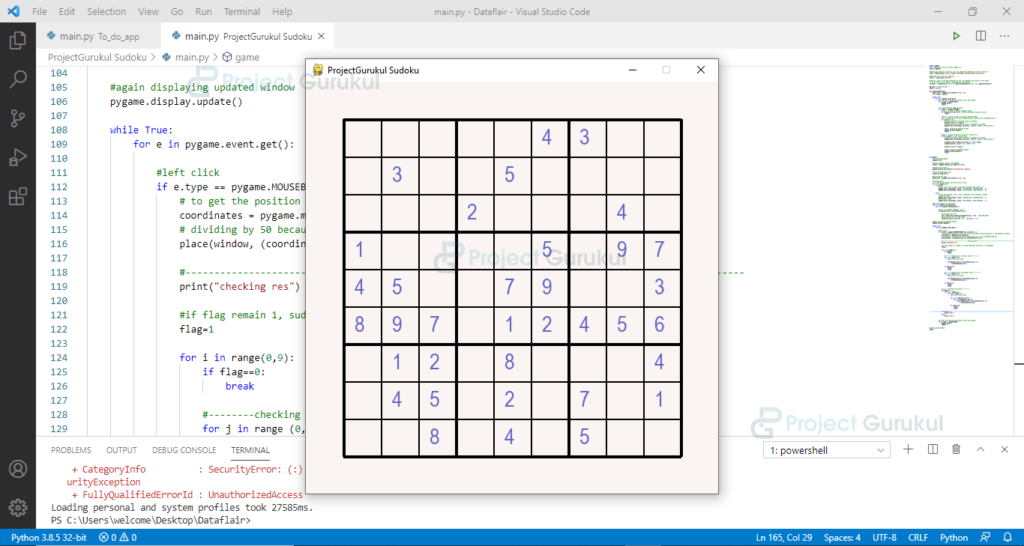
Another mention of the underlying problem occurred in a 1956 letter written by Kurt Gödel to John von Neumann. If proved (and Nash was suitably skeptical), this would imply what is now called P ≠ NP, since a proposed key can easily be verified in polynomial time.
#SUDOKU SOLVER PYTHON CODE#
In 1955, mathematician John Nash wrote a letter to the NSA, in which he speculated that cracking a sufficiently complex code would require time exponential in the length of the key. The precise statement of the P versus NP problem was introduced in 1971 by Stephen Cook in his seminal paper "The complexity of theorem proving procedures" (and independently by Leonid Levin in 1973 ).Īlthough the P versus NP problem was formally defined in 1971, there were previous inklings of the problems involved, the difficulty of proof, and the potential consequences. Decades of searching have not yielded a fast solution to any of these problems, so most scientists suspect that none of these problems can be solved quickly. Researchers have shown that many of the problems in NP have the extra property that a fast solution to any one of them could be used to build a quick solution to any other problem in NP, a property called NP-completeness. Thousands of other problems seem similar, in that they are fast to check but slow to solve. So, Sudoku is in NP (quickly checkable) but does not seem to be in P (quickly solvable). However, all known algorithms for finding solutions take, for difficult examples, time that grows exponentially as the grid gets bigger. Given an incomplete Sudoku grid, of any size, is there at least one legal solution? Any proposed solution is easily verified, and the time to check a solution grows slowly (polynomially) as the grid gets bigger. It is one of the seven Millennium Prize Problems selected by the Clay Mathematics Institute, each of which carries a US$1,000,000 prize for the first correct solution.Ĭonsider Sudoku, a game where the player is given a partially filled-in grid of numbers and attempts to complete the grid following certain rules. Aside from being an important problem in computational theory, a proof either way would have profound implications for mathematics, cryptography, algorithm research, artificial intelligence, game theory, multimedia processing, philosophy, economics and many other fields. The problem has been called the most important open problem in computer science. If it turns out that P ≠ NP, which is widely believed, it would mean that there are problems in NP that are harder to compute than to verify: they could not be solved in polynomial time, but the answer could be verified in polynomial time.

Īn answer to the P versus NP question would determine whether problems that can be verified in polynomial time can also be solved in polynomial time. The class of questions for which an answer can be verified in polynomial time is NP, which stands for "nondeterministic polynomial time".

For some questions, there is no known way to find an answer quickly, but if one is provided with information showing what the answer is, it is possible to verify the answer quickly. The general class of questions for which some algorithm can provide an answer in polynomial time is " P" or " class P". The informal term quickly, used above, means the existence of an algorithm solving the task that runs in polynomial time, such that the time to complete the task varies as a polynomial function on the size of the input to the algorithm (as opposed to, say, exponential time). In informal terms, it asks whether every problem whose solution can be quickly verified can also be quickly solved. Make sure to test your code exhaustively to cover all edge cases.The P versus NP problem is a major unsolved problem in theoretical computer science. However, after submission your code will be tested with some hidden test cases.
#SUDOKU SOLVER PYTHON FULL#
Post errors, ask for hints and help others, but please don't share the full solution answer code on Slack to give others a chance to write the code themselves. If you are stuck, you can ask for help on the bootcamp Slack group.Questions marked (Optional) will not be considered for evaluation, and can be skipped.Since you'll be using a temporary online service for code execution, save your work by running mit at regular intervals.

In some cases, you may need to add some code cells or new statements before or after the line of code containing the ?.Do not change variable names, delete cells or disturb other existing code.Make sure to run all the code cells, otherwise you may get errors like NameError for undefined variables.


 0 kommentar(er)
0 kommentar(er)
